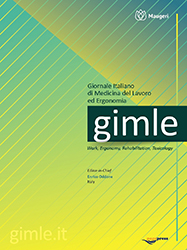Risk factors for intoxications in the workplace: a case-control study on data from the Poison Control Center of Policlinico Umberto I of Rome
All claims expressed in this article are solely those of the authors and do not necessarily represent those of their affiliated organizations, or those of the publisher, the editors and the reviewers. Any product that may be evaluated in this article or claim that may be made by its manufacturer is not guaranteed or endorsed by the publisher.
Authors
Background. The term intoxication refers to the disease, acute or chronic, caused by harmful substances or those made harmful due to factors such as high concentration or impaired immune defenses. These substances can cause reversible or irreversible changes in tissues and organs, including oncogenic and mutagenic effects. In response to the need for treatment and prevention services for intoxication and chemical impacts, poison control centers (PCCs) have emerged worldwide. This study aimed to verify the link between the type of intoxication detected by the PCC of the Policlinico Umberto I of Rome and occupational exposure.
Methods. The study employed a retrospective case-control design. Cases and controls were identified from the archive of the Clinical Toxicology Unit – Poison Control and Anti-Drug Center at Policlinico Umberto I, which included individuals who had contacted the PCC between 2009 and 2018. The case group comprised patients whose intoxication occurred at the workplace and/or was accidental and work-related. Controls were randomly selected from the PCC database using EpiCalc2000, excluding those who met the case criteria.
Results. A total of 448 patients were included (202 cases, 246 controls). The most involved agents were drugs (44.7% controls, 3.5% cases), caustic cleaning products (19.7% controls, 27.7% cases), fuels, solvents, paints, oils (2.5% controls, 22.8% cases), and pesticides (5.3% controls, 12.9% cases). Ingestion was the primary exposure route among cases (68.6%), while inhalation prevailed among controls (46.5%). Multivariate analysis revealed that occupational intoxication was strongly associated with exposure to other toxic substances (OR 55.19), fuels, solvents, paints, oils (OR 48.36), and pesticides (OR 12.61). Conversely, the association with risk factors such as drugs (OR 0.06), substances of abuse (OR 0.10), and mushrooms (OR 0.10) was found to be protective.
Conclusions. The primary routes of exposure to toxic substances in the workplace were inhalation in approximately half of the cases and ingestion in just over a quarter of the cases. The substances most commonly involved were caustic cleaning products and fuels, solvents, paints, and oils. These results may facilitate the development of specific prevention strategies.
How to Cite

This work is licensed under a Creative Commons Attribution-NonCommercial 4.0 International License.
PAGEPress has chosen to apply the Creative Commons Attribution NonCommercial 4.0 International License (CC BY-NC 4.0) to all manuscripts to be published.






